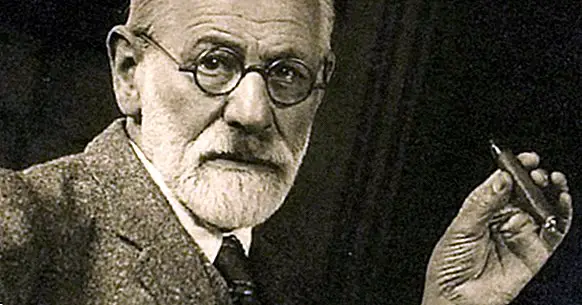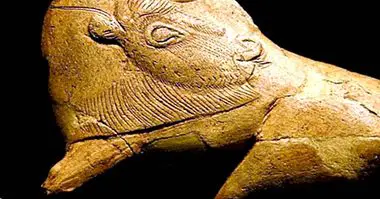What is 'free association' in Psychoanalysis?
Free association is one of the methods most closely linked to psychoanalysis of Sigmund Freud and his followers. At the time, this strategy served to replace the hypnosis and the catharchical method in the clinical consultation of the time, and today it is still very recurrent in the various schools of psychology related to the psychodynamic current.
In this article we will see exactly what the free association consists of and on what theoretical assumptions it is based.
What is free association?
Viewed superficially, free association can be summarized in one sentence: "tell me everything that comes to mind"; an activity seen from outside of Freudian theory seems idle and lacking a clear purpose. But nevertheless, it is also a fundamental rule of psychoanalysis .
In short, free association is a method to make some aspects of ideas and memories that are too traumatic to be accessible by consciousness (understood within the theoretical framework of psychoanalysis) can be revealed indirectly through language .
Somehow, Sigmund Freud argued that free association was a way to overcome the mechanisms of repression and blocking of traumatic mental contents and generators of much anxiety. In this way, by having a patient play with the language in an improvised way, the psychoanalyst would be able to reach a deeper level of understanding about the inhibited problems of that person.
The birth of the concept
The free association was born in a historical context in which it was necessary to treat many patients with mental disorders of neurotic type, a very broad diagnostic category that served to encompass actions and thought forms related to abrupt changes in mood and the degree of activation mental.
Just before beginning to formulate the bases of psychoanalysis, Sigmund Freud he was very influenced by Jean-Martin Charcot , a French neurologist who used hypnosis and the cathartic method to cure cases of hysteria. Freud decided to use hypnosis to explore the ailments of neurotic patients, although it took him a short time to come to a very different conclusion about how the disorders should be treated.
Freud started thinking about the idea that mental problems could really be manifestations of ideas and traumatic memories that are so stressful that they must be "isolated" and kept away from the reach of consciousness. The organism is able to maintain a certain balance between the contents that actually circulate through the consciousness and those that remain in the unconscious, but it is not able to make the latter disappear, it only keeps them blocked. However, sometimes the contents to be repressed are so powerful that they generate the symptoms of the disorders as they struggle to filter themselves towards consciousness.
Hypnosis would be a way to make the locking mechanisms of these hidden mental contents relaxed , making it possible for them to express themselves more clearly (although always indirectly). With dreams something similar would happen: Freud interpreted them as hypothetical manifestations of the unconscious and repressed, passed through a filter of symbolism.
But the free association would allow to know and work with the contents of the unconscious in a more efficient way. Let's see why.
Release the contents of the unconscious
As we have seen, the method of free association is based on these assumptions:
- There is at least one conscious part of the psyche, and another that is unconscious.
- The contents of the unconscious part struggle to emerge into consciousness, but they can never be directly examined.
- Many mental disorders are the result of the clash between contents of the unconscious that want to occupy the rest of the psyche and the conscious part that tries to prevent this.
- It is possible to create situations in which the mechanisms of blocking the contents of the unconscious are relaxed.
Considering this, the psychoanalyst uses the free association to allow contents of the unconscious that may be behind the onset of a mental disorder to be expressed indirectly, in this way, to be able to influence them through language mechanisms.
In this way, the patient is allowed to say everything that comes to mind, without imposing conditions or veto issues; In this way, their self-censorship mechanisms are relaxed. By creating a context in which the use of language can be chaotic, it is assumed that it is the unconscious part of the psyche that is responsible for linking words and themes to each other .
In this way, the logic behind what is said becomes the logic of the unconscious, something that must be discovered by the psychoanalyst, who is taking note of regularities in the use of symbols, topics that seem important but are never talked about directly and that seem to act as the center of a whirlpool of phrases
These ideas and hidden meanings are raised by the psychoanalyst, who gives an interpretation of what he has just heard. These new meanings must be addressed by the patient once the therapist offers an interpretation of what he has said that fits with what he himself is unable to express directly in words.
According to Freud, this method was much more useful than hypnosis and the use of catharsis, because it could be used in a larger number of people and allowed to rework discourses of the unconscious instead of simply waiting for the patient to find a way to reconcile with the contents of the unconscious by reviving them.
- Related article: "The Theory of the Unconscious of Sigmund Freud (and the new theories)"
The problems of free association
With this, we have already seen the basic aspects that characterize free association. However, all this explanation is valid only if we accept the theoretical framework of Freud's psychoanalysis and the epistemology from which it departs.
This last component is what makes both free association and all psychoanalytic theory in general has been criticized, especially by philosophers of science such as Karl Popper; basically, there is no way to set specific goals, implement a specific method and evaluate if it has worked or not, because everything depends on the interpretations.
In short, the interpretation made by a psychoanalyst from the torrent of words and phrases that the patient is issuing during the free association will be valid to the extent that the patient considers it; but, at the same time, the patient is not able to be a reliable connoisseur of what is happening in his head, so he can always be questioned.
In addition, the assumptions that in the mental life of people there are conscious and unconscious entities that act with their own agenda is considered an entelechy, because it is something impossible to demonstrate: the unconscious part will always manage not to be revealed.
Thus, in the practice of contemporary psychology, free association remains one of the elements of the history of psychology, but it is not considered a scientifically valid tool.



















